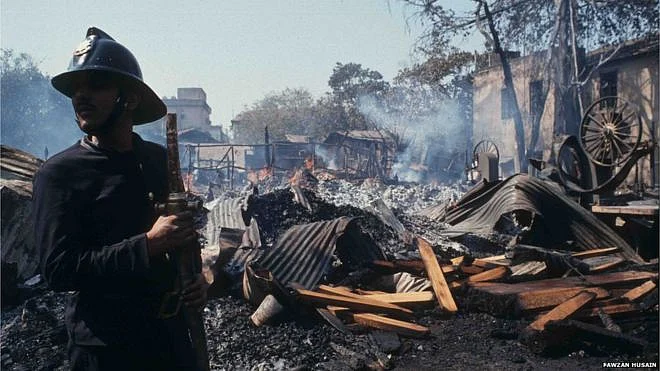It was just a little before 1.30 pm when we heard the blasts. I had just finished lunch with my colleagues in the Central Railways Head Quarters office, where I worked in the General Manager’s office. We heard something that sounded like fire-crackers, just as lunch hour was ending.
Its full strength, in sound and fury, could not reach us as the Victoria Terminus building is not in the immediate vicinity of Dalal Street, as anyone who knows Mumbai would know. But the scale of the tragedy would unfold.
Within minutes, the office broke out into chaos. Words like “bomb blast” and “Share Bazar” filled the air. But no one seemed to have a clear idea of what was happening. Someone said that there had been a blast at the Bombay Stock Exchange and that Dalal Street was now a site of carnage.
Remember, this was before the internet or cellphones became commonplace. Landlines with ancient dialer devices were in use. A colleague was frantically asking if anyone had seen our colleague Vinayak Bhave. “Why?” I asked. “The boss had sent him to Dalal Street today and he hasn’t yet returned,” he replied.
Soon, we heard sirens from police vans and ambulances. The sirens continued to blare for the next few hours.
The police were rushing to the site of carnage and ambulances were bringing the dead and injured to St George’s hospital, next to my office.
The air was thick with tension, almost palpable. Announcements were being made on megaphones. “Please come forth to donate blood,” we were asked.
Bhave, the missing colleague, returned safe and sound. But he had gory tales to tell. He said he was a little away from the BSE building when he heard the terrible blast that was followed by a cloud of smoke and dust.
As Suhas Gokhale a distant cousin who was with the Maharashtra Unit of SPG, was to tell me later, the RDX bomb, that went off in the basement parking of the BSE building, was so powerful that more than 80 people died due to the impact and over 200 suffered grave injuries.
But the pillar of the building that received most of the impact was strong, allowing the guard standing behind it to escape alive, albeit with blasted ear drums. The building stood firm .
The pillar was later reinforced without the need to fell the structure, unlike the Plaza Cinema building (one of sites of the twelve blasts that day), which had to be felled and rebuilt.
Back to the afternoon of the blast. Some of my colleagues, who rushed to St George’s to donate blood, came back with stories about how this was one of a series of blasts. The road to St George’s main entrance was covered in blood, they said.
I was scared. But there was no way I could contact my family in Nashik and tell them I was alright.
All phone lines were down, a regular feature since the previous December (1992) and January (1993) riots, that had shattered the metropolis’ calm and peace in the aftermath of the Babri Masjid felling.
It was a Friday and while we were all worried about the chaos around us, we weren’t about to get an early break from work.
Then we saw the Army vans from the office window. The streets were growing quiet as people began rushing home after 3 pm. Around 5 pm, the Army vans began holding a flag march in the area, to warn possible rioters to refrain from carrying out arson or any other attacks. That is when our boss relented and said we could leave.
That evening, my fellow hostellers narrated tales of the horror at the other 11 sites of blasts. Scenes they had witnessed and scenes that were narrated to them.
The following day, Prime Narsimha Rao was in Mumbai, with my cousin Gokhale in the second tier of the Ring Round of SPG around him. Gokhale confirms that Rao visited blast sites like the Air India Building, the Bombay Stock Exchange and met with the victims who were being treated at St George’s Hospital.
The serial blasts were an act of terror. But the one thing that the blasts did was to restitch the fabric of harmony in Mumbai that had been shredded by the the riots after Babri Masjid incident.
Hindus and Muslims, especially in the Katha Bazar in Paidhuni and Fisherman’s Colony in Mahim could be seen rushing to help the injured.
My Mumbai was back on its feet the very next day.
And on Monday I was back in office, to work under the despotic boss who did not allow us to leave even after the unprecedented had happened.
(This story was first published on 12 March 2017. It is being reposted from The Quint’s archives as the TADA court in Mumbai pronounces the quantum of sentence for five convicts in the 1993 Mumbai blasts.)
(At The Quint, we question everything. Play an active role in shaping our journalism by becoming a member today.)
